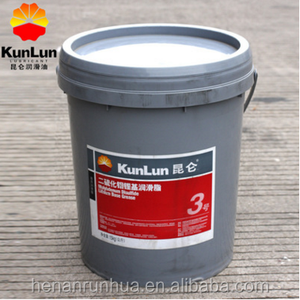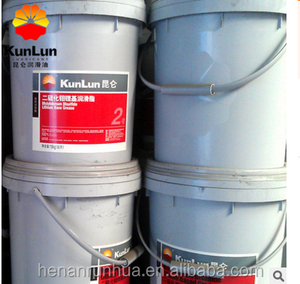(631 products available)


















































































































































































Mos2 grease is a specialized lubricant that contains molybdenum disulfide (MoS2) as a key component. It's designed to reduce friction and wear in various mechanical systems. MoS2 grease is commonly used in high-pressure, high-temperature, and heavy-load applications. The inclusion of molybdenum disulfide makes this grease exceptionally suitable for conditions where conventional lubricants may fail to provide adequate performance. Here are some of the common types of MoS2 grease:
Calcium-Molybdenum Grease
This is a thick, waterproof grease that is used in bearings and other parts of vehicles. It reduces friction and stops rust from building up. The main ingredient that helps with this is molybdenum disulfide (MoS2).
Aluminum-Molybdenum Disulfide Grease
This is a special grease made for high-pressure and high-temperature places. It has aluminum in it, which helps it stick to surfaces really well, making it great for places like the axles of cars or the joints in heavy machinery that move a lot.
Lithium-Molybdenum Disulfide Grease
It is a versatile grease that is good to use in many different places. It works well in places that do not get too hot or too cold. This makes it a good choice for regular car maintenance or taking care of farm equipment. It has lithium in it, which makes it a reliable and affordable option for everyday use.
Bentonite-Molybdenum Disulfide Grease
It is a unique blend that takes advantage of bentonite clay's thickening properties. This is useful in places like the oil rigs or in mining since it can withstand extreme conditions. The bentonite helps the grease stay thick and not runny, even when the weather is really hot or really cold.
Synthetic-Molybdenum Grease
It is a cutting-edge solution for modern industries. This grease has been specially made in a lab to have the best qualities for places like the aerospace industry or high-tech factories. Its molecules are very small, allowing it to coat surfaces evenly and stick well. Plus, it can handle extreme temperatures and pressures, making it reliable in critical applications.
The MoS2 grease has various specifications that make it applicable in different industries. The following are some of the specifications:
Consistency
The level of hardness or texture of the grease is referred to as consistency. The consistency of the grease is important as it determines its performance. The performance is dependent on how well the grease can hold onto surfaces and flow into various parts of the machinery. The MoS2 grease has different consistencies from soft to hard.
Base Oil
The performance of the grease is influenced by its base oil. This is because the base oil determines the viscosity and the flow of the grease. The MoS2 grease has different base oils such as mineral oil and synthetic oil.
Additives
The additives included in the grease improve its performance. The additives offer different properties such as oxidation resistance and corrosion prevention. The MoS2 grease has various additives that include anti-wear agents, extreme pressure agents, and rust inhibitors.
Color and Appearance
The color and appearance of the grease are not important for its performance. However, the appearance and color can be used to identify various types of grease. The MoS2 grease is usually black due to the presence of molybdenum disulfide.
Temperature Range
The effective functioning of the grease at elevated temperatures and low temperatures is referred to as the temperature range. The grease's temperature range allows it to maintain its consistency and performance at different temperatures. The MoS2 grease has a temperature range that allows it to function in diverse industrial settings.
Maintaining the MoS2 grease is crucial for optimal performance. Here are some of the maintenance tips;
1. Proper Storage
To maintain the quality of the grease, it should be stored in a cool place away from sunlight and at room temperature. Also, the containers in which the grease is stored should be tightly sealed to avoid contamination.
2. Regular Replacement
The grease should be replaced at the recommended intervals to maintain its performance. Before replacing the grease, the old grease should be completely removed to avoid mixing which may lead to the formation of ineffective lubrication.
3. Cleanliness
Before applying the MoS2 grease, the surfaces should be clean to avoid contamination. This can be done by cleaning the surfaces with a suitable solvent or cloth.
4. Inspection
The grease should be inspected regularly for any signs of contamination, such as discoloration or change in texture. There should be a prompt replacement if there is any sign of contamination.
5. Application
The MoS2 grease should be applied in the right amounts to the required parts of the machinery. Over or under application should be avoided.
When buying grease, consider the following:
Understand the application where the grease will be used. Different applications have different requirements. For example, high-speed applications require a high-lubricating grease that has a low friction coefficient, while high-load applications require heavy lubrication.
Different types of greases are suited for various applications. Grease for electric motors may not be ideal for wheel bearings. It is important to choose the right type of grease for the specific application.
Suppliers or manufacturers of greases provide lubrication guidance on which type of grease to use for a specific application. Take advantage of their expertise and advice to choose the right type of grease.
Consider the operating conditions such as temperature, speed, and load. Operating conditions are an important factor in deciding which type of grease to buy. If operating conditions are extreme, look for a grease that is formulated to withstand those conditions.
Check the compatibility of the grease with the existing lubricants. If unsure, consult the supplier or manufacturer.
Take into consideration the performance characteristics of the grease such as stability, load carrying ability, and corrosion resistance.
Decide on the budget but do not compromise on quality. Mos2 grease comes in different qualities and prices. Choose a quality grease that will last longer and give value for money.
Once the right type of grease has been chosen, maintain a regular schedule for grease application. This will reduce wear and tear of equipment and increase their lifespan.
Replacing MoS2 grease is a straightforward task that can be accomplished by following a few simple steps. By using only the right tools, it will be easy to apply the desired product precisely where it is needed. Before starting, ensure that the tool or machine being lubricated is turned off and, if necessary, unplugged to prevent accidents. Make sure to have the following items on hand:
Once everything is in place, adhere to these steps:
Q1: How often should one use MoS2 grease?
A1: The frequency of applying MoS2 grease depends on several factors, including the type of machinery, operating conditions, and the grease's performance. However, it is generally recommended to reapply the grease after a specific number of hours of operation or at regular intervals, such as every three to six months. Users should always adhere to the manufacturer's instructions.
Q2: Is MoS2 grease suitable for high-speed applications?
A2: While MoS2 grease is primarily used for high-pressure and extreme temperature applications, it may not be the best choice for high-speed applications due to its consistency. In such cases, a lithium-based or synthetic grease with similar properties to MoS2 may be more appropriate. Nonetheless, specific formulations of MoS2 grease are suitable for high-speed operations.
Q3: Can I use MoS2 grease on electric motors?
A3: Yes, MoS2 grease can be used in components such as bearings that require lubrication in electric motors. Nevertheless, it is crucial to use a formulation that is compatible with the materials used in the electric motor, especially in the stator and rotor.
Q4: What is the shelf life of MoS2 grease?
A4: The shelf life of MoS2 grease can vary depending on the formulation and storage conditions. Generally, it ranges from three to five years. To ensure optimal performance and longevity, users should store the grease in a cool, dry place away from direct sunlight and extreme temperatures.
Q5: Is MoS2 grease waterproof?
A5: Yes, MoS2 grease has water-resistant properties, making it suitable for applications exposed to moisture or water. Nonetheless, while it can withstand water contact, it is advisable to choose a specific formulation designed for underwater or highly humid environments to ensure optimal performance in extreme conditions.